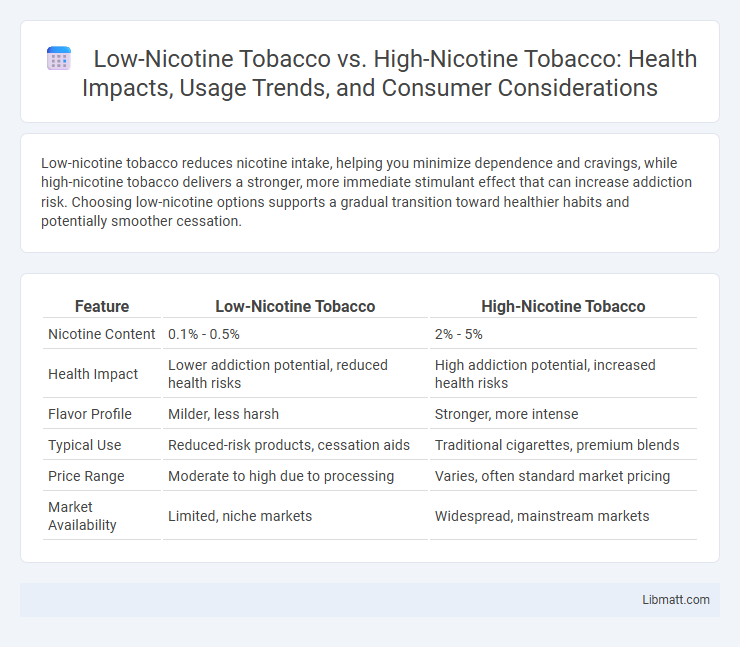Low-nicotine tobacco reduces nicotine intake, helping you minimize dependence and cravings, while high-nicotine tobacco delivers a stronger, more immediate stimulant effect that can increase addiction risk. Choosing low-nicotine options supports a gradual transition toward healthier habits and potentially smoother cessation.
Table of Comparison
| Feature | Low-Nicotine Tobacco | High-Nicotine Tobacco |
|---|---|---|
| Nicotine Content | 0.1% - 0.5% | 2% - 5% |
| Health Impact | Lower addiction potential, reduced health risks | High addiction potential, increased health risks |
| Flavor Profile | Milder, less harsh | Stronger, more intense |
| Typical Use | Reduced-risk products, cessation aids | Traditional cigarettes, premium blends |
| Price Range | Moderate to high due to processing | Varies, often standard market pricing |
| Market Availability | Limited, niche markets | Widespread, mainstream markets |
Understanding Low-Nicotine vs High-Nicotine Tobacco
Low-nicotine tobacco contains significantly reduced levels of nicotine compared to high-nicotine tobacco, impacting addiction potential and user experience. Choosing low-nicotine tobacco can help reduce nicotine dependence and ease the transition to quitting, while high-nicotine tobacco delivers a stronger stimulant effect and greater risk of addiction. Your preference may influence the intensity of nicotine withdrawal symptoms and overall health outcomes.
Chemical Composition Differences
Low-nicotine tobacco contains significantly reduced levels of nicotine alkaloids compared to high-nicotine tobacco, resulting in diminished addictive potential. The chemical profile of low-nicotine varieties often includes altered ratios of minor alkaloids such as nornicotine and anatabine, affecting the overall flavor and aroma compounds. Your choice between these tobaccos impacts not only nicotine intake but also the presence of volatile organic compounds and tobacco-specific nitrosamines linked to health risks.
Health Impacts of Nicotine Levels
Low-nicotine tobacco reduces the addictive potential and may lower risks associated with nicotine dependence, including cardiovascular issues and respiratory problems. High-nicotine tobacco delivers more nicotine per use, increasing the likelihood of addiction and adverse health effects such as elevated heart rate and blood pressure. Choosing low-nicotine products can support efforts to minimize health impacts while managing nicotine intake more effectively for Your well-being.
Addiction Potential: Low vs High Nicotine
Low-nicotine tobacco contains significantly less nicotine, resulting in a reduced addiction potential compared to high-nicotine tobacco, which delivers stronger and faster nicotine effects that reinforce dependency. Your body's craving for nicotine grows more intense with high-nicotine tobacco, increasing the difficulty of quitting. Choosing low-nicotine tobacco may help lower the risk of developing severe nicotine addiction and ease the cessation process.
Flavor and Sensory Experience
Low-nicotine tobacco offers a milder, smoother flavor with less harshness and bitterness, enhancing the subtle, natural tobacco notes appreciated by smokers seeking a gentler sensory experience. High-nicotine tobacco delivers a stronger, more robust flavor profile with pronounced bitterness and a sharper throat hit, intensifying the overall sensory impact preferred by users desiring a bold taste and powerful nicotine delivery. The difference in nicotine content significantly influences the aroma, taste complexity, and mouthfeel, shaping consumer preferences between mellow and intense smoking experiences.
Regulatory Policies and Legal Limits
Regulatory policies for low-nicotine tobacco often impose strict legal limits to reduce nicotine content, aiming to lower addiction risks and promote public health. High-nicotine tobacco faces tighter regulations in many jurisdictions, including limits on packaging, marketing, and sales to minors, reflecting concerns over its addictive potential. Your compliance with these evolving laws is crucial for legal distribution and consumer safety.
Consumer Preferences and Trends
Consumer preferences show a rising interest in low-nicotine tobacco due to increasing health awareness and regulatory pressures aimed at reducing nicotine intake. High-nicotine tobacco remains popular among traditional smokers seeking stronger effects and faster nicotine delivery. Market trends indicate a shift as low-nicotine products gain traction, especially in regions with stringent tobacco control policies and growing demand for harm reduction alternatives.
Harm Reduction: Can Lower Nicotine Help?
Low-nicotine tobacco products significantly reduce nicotine exposure, which may help decrease dependence and the risk of addiction compared to high-nicotine variants. Studies indicate that smokers using low-nicotine tobacco often consume fewer cigarettes and exhibit improved cessation rates, suggesting potential benefits for harm reduction strategies. However, comprehensive data on long-term health outcomes remain limited, emphasizing the need for further research on low-nicotine tobacco's effectiveness in reducing smoking-related harm.
Agricultural Practices Affecting Nicotine Content
Agricultural practices such as soil composition, fertilization methods, and curing techniques significantly influence nicotine levels in tobacco plants, with high-nicotine tobacco often cultivated in nutrient-rich soils and subjected to specific curing processes that enhance alkaloid accumulation. Low-nicotine tobacco varieties typically involve genetic selection combined with tailored agricultural inputs to reduce nicotine biosynthesis pathways, while maintaining leaf quality. Controlled irrigation and precise harvest timing further modulate nicotine concentration, making agronomic management a critical factor in customizing tobacco for nicotine content.
Future of Nicotine Levels in Tobacco Products
Low-nicotine tobacco varieties are gaining traction as regulatory bodies worldwide push for reduced nicotine content to curb addiction and promote public health. Advances in agricultural biotechnology enable the development of tobacco plants with precisely controlled nicotine concentrations, shaping the future landscape of tobacco products. Your choice between low- and high-nicotine tobacco may influence regulatory compliance and health outcomes as industry standards evolve towards minimizing nicotine dependence.
low-nicotine tobacco vs high-nicotine tobacco Infographic

 libmatt.com
libmatt.com